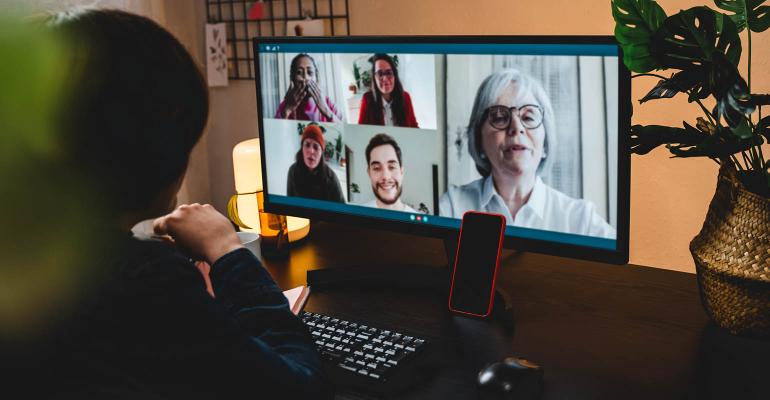
Five Best Practices for Online Family Meetings
 Vanessa Nunes/iStock/Getty Images Plus Wealth Planning>High Net Worth Five Best Practices for Online Family Meetings Virtual meetings require a different approach.
Vanessa Nunes/iStock/Getty Images Plus Wealth Planning>High Net Worth Five Best Practices for Online Family Meetings Virtual meetings require a different approach. Family enterprises were impacted in many ways by COVID-19, with many families placing their focus on the core business both to survive and take advantage of this time to put forth new initiatives that had been put on the back burner.
In the face of these unprecedented circumstances, businesses had to make sharp, critical pivots to account for threats to their core business, while increasing safety protocols, establishing new operating procedures and implementing and relying on new technology—all under incredible circumstances and financial pressures. While this focus on keeping the business going in the short term is critical, the family enterprises that have made it through this moment and beyond also have their eye on the long term, focusing on business and on the family.
A key facet of both business and family engagement, naturally, is meeting face to face; however, the reality of COVID-19 dictated that doing so in-person was largely not worth the risk. As a result, families had to get creative to maintain connection with one another. Virtual meetings became ubiquitous, and some families continue to meet virtually even after the worst of the pandemic has passed. They’ve discovered that while in-person meetings may provide more intimate moments among family members, virtual meetings also have benefits and may be interspersed with in-person ones.
But virtual meetings require a different approach along with deliberate effort and planning. Here are some lessons we’ve learned about what works and what doesn’t when it comes to these virtual family meetings.
The Silver Lining
The primary benefit of virtual meetings is the ease of convening (especially for large families). Families had to coordinate dates and puzzle-piece through distance, travel and logistics to convene a traditional, in-person family gathering. The frenzy of the planning itself can distract from the very reason a family is getting together in the first place—to connect, to inform and to learn together. Attention to logistics is always crucial, but the relative ease of convening virtual meetings allows the family to re-channel its energy towards meeting design (agendas, goals and results), material creation and technological considerations rather than worrying about things like how the Smiths will be getting to Florida, when Maggie will be on school break and what food allergies and preferences to account for.
We’ve also found that families who traditionally manage to only have 75% of family members present for in-person gatherings are now experiencing nearly 100% participation—a result of the increased ease of attendance. To focus deeper on who is showing up and how they’re showing up, we’ve found that it’s possible to increase engagement from next-generation members given their comfort and familiarity with the video platforms used for most meetings. This yields greater participation and contributions from an age group that may otherwise feel out of its element amid large, in-person meetings. Zoom also helps level the playing field—with everyone having an equal share of the screen and position in the room within the virtual “boxes” they occupy.
Virtual formats also make it easier to break meetings up into bite-sized, digestible chunks, which reduces meeting fatigue and can help sustain the attention and focus of family members. Instead of a full-day gathering (involving activities and content for eight hours straight, with dinners and activities in between), many families have opted out of adapting to full-day eight-hour video meetings (understandably so), instead choosing to hold multiple 90-minute meetings over the course of a couple of months. With the right amount of follow-up and confirmed next steps in place, this meeting cadence can also work to support the goal of creating continuity and connection between sessions.
Tips, Tricks and Best Practices
Below are a few of our key best practices to keep in mind when executing virtual family meetings, including how to structure and sequence conversations and some technical tips for making them happen.
 Comment * Switch to plain text editor
Comment * Switch to plain text editorMore information about text formats
Text format CommentsPlain text Comments- Allowed HTML tags: <em> <strong> <blockquote> <br> <p>
- No HTML tags allowed.
- Web page addresses and e-mail addresses turn into links automatically.
- Lines and paragraphs break automatically.
- Load More
- Next Article
- Previous Article
Owl Media Group takes pride in providing social-first platforms which equally benefit and facilitate engagement between businesses and consumers and creating much-needed balance to make conducting business, easier, safer, faster and better. The vision behind every platform in the Owl Media suite is to make lives better and foster a healthy environment in which parties can conduct business efficiently. Facilitating free and fair business relationships is crucial for any thriving economy and Owl Media bridges the gap and open doors for transparent and successful transacting. No advertising funds influence the functionality of our media platforms because we value authenticity and never compromise on quality no matter how lucrative the offers from advertisers may seem.
Originally posted on: https://www.wealthmanagement.com/high-net-worth/five-best-practices-online-family-meetings